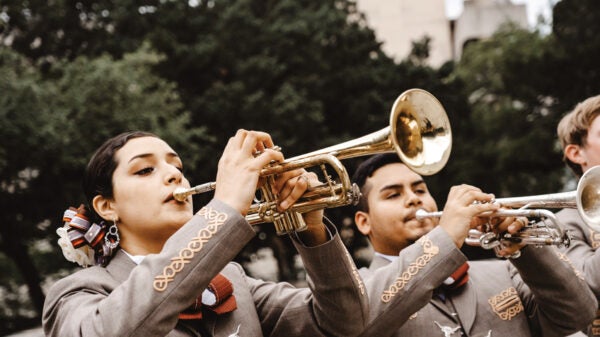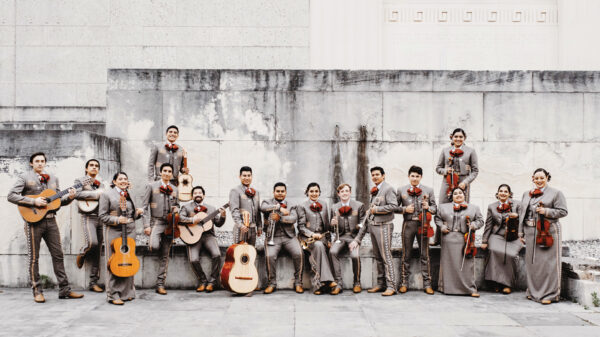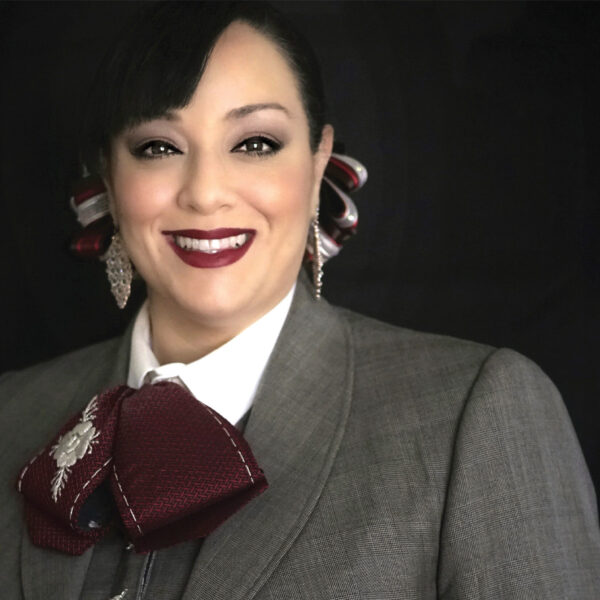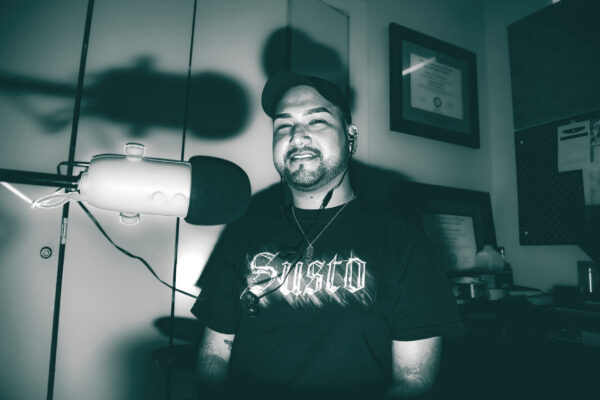Mónica Fogelquist spent her undergraduate years splitting time between being a college student and a professional mariachi musician. It was no easy feat.
As a violinist and singer with the prestigious all-female mariachi group, Mariachi Reyna de Los Ángeles, she regularly juggled traveling to mariachi performances and making it to class, fulfilling mariachi social obligations and staying on top of her assigned readings.
“I guess in retrospect, I don’t know if I would try to become a professional mariachi musician and a full-time college student at the same time,” Fogelquist says with a chuckle. “But that’s just what happened.”
That was in the early 2000s. Now, Fogelquist is a professor of mariachi and ethnomusicology at The University of Texas, journal editor and the director of UT’s mariachi ensemble, Mariachi Paredes. A longtime listener and performer of mariachi music, she shares her knowledge with students and educators both familiar and new to the traditional Mexican music genre.
Mariachi music first appeared in the central western region of Mexico in the late 18th or early 19th century. It incorporates rhythms from African and Indigenous populations and utilizes the musical system and Spanish language that were brought to Mexico by the conquistadors.
Today, mariachi is the ultimate representative of Mexican music all over the world, Fogelquist says. A standard mariachi includes six to seven violins, two to three trumpets and one standard guitar. It also includes two instruments specific to the genre: the guitarron, a large bass guitar, and the vihuela, a smaller, higher-pitched rhythmic guitar. A harp is optional and considered a luxury instrument in a group.
Most people go to church – we went to Sunday brunch to listen to mariachi.
A lifelong musician
Fogelquist’s introduction to mariachi music started when she was born. Her father, Mark Fogelquist, a mariachi musician, ran a restaurant in Orange, California, that featured his professional mariachi ensemble. Every Sunday morning, a young Mónica and her mother would visit the restaurant and listen to the group perform.
“Almost immediately from birth, my mom and I were there every Sunday,” Fogelquist says. “Most people go to church — we went to Sunday brunch to listen to mariachi.”
Fogelquist wasn’t immediately interested in playing mariachi music herself, but that desire changed several years later when she moved with her family to Wenatchee, Washington. Now a middle schooler, she had been practicing classical violin for a few years, and when her father formed a mariachi student group at a local high school, he asked her to help out.
“He said, ‘You’re the only other violinist that I know in town who has any experience, so you have to help me,’” Fogelquist says. “So, when I was 11, I started playing mariachi music. And I think part of my enthusiasm and excitement for the music was that I was this little girl among all these high school kids. … It became a social thing, and I was surrounded by my peers who were excited about the music.”
During the seven years she was a part of the student group, Fogelquist performed hundreds of times, traveled across the Pacific Northwest and took part in workshops with renowned professional mariachi musicians. By the time she graduated from high school, Fogelquist had decided that she wanted to become a professional mariachi musician.
She started her undergraduate studies at Whittier College in California and joined Mariachi Reyna. Though it was difficult to balance school and mariachi, Fogelquist says her time spent learning from the group’s leader, famed musician José Hernández, was one of the greatest musical experiences she’s ever had.
When she graduated from Whittier, Fogelquist began teaching mariachi at a local middle and high school. Motivated by many factors, including her affinity for teaching and the additional job security teaching could provide, she says she decided to set professional mariachi playing aside and focus solely on her teaching career.
Fogelquist taught at different public schools while she obtained a teaching degree from San Diego State University and a master’s degree in ethnomusicology at The University of Texas Rio Grande Valley. At UTRGV, she played with the school’s Mariachi Aztlan, an experience that meshed well with her studies.
Fogelquist taught mariachi music for two years at a high school in Las Vegas before applying to her current position at UT. She started teaching in Austin in the fall of 2018.

Teaching mariachi
Each semester, Fogelquist alternates teaching classes about mariachi history and regional styles of Mexican and U.S.-Mexican border music. She also directs UT’s Mariachi Paredes.
The mariachi band includes 14 students, which Fogelquist notes is bigger than a standard ensemble, and rehearses twice a week. During a normal year, they perform concerts at the Butler School of Music, as well as during events held on campus and in the Austin community. During the COVID-19 pandemic, the group could not meet in person to rehearse or perform, but the members kept the music going by recording videos individually, editing them together into a single video and posting them as a series on Facebook.
As director of the group, Fogelquist provides musical guidance and takes care of all the behind-the-scenes administrative work the ensemble needs. In addition to coming up with the mariachi ensemble’s repertoire list and running rehearsals, she books performances and orders students’ uniforms. She is particular about the kind of music that the ensemble performs, choosing to assign traditional mariachi pieces rather than fusion-type music.
“Right now in the mariachi world, there’s a lot of mixing of music, borrowing from other genres of music and … (there are) these crazy, souped-up arrangements that tend to stray away from the traditional foundation,” Fogelquist says. “By adhering a little bit more to the traditional side, I sort of feel like that’s our innovation, because everyone is trying to sort of outdo each other in terms of these fancy arrangements.”
Wilmer Rodriguez, a recent UT graduate who served as section leader for violin in Mariachi Paredes, says he appreciated the traditional music Fogelquist chose for the group. He says that when she began leading the mariachi ensemble during his second year in it, she worked to help the group strengthen its technique and play more cohesively.
“Immediately as she came in, she was super focused (on) wanting to improve everybody … making sure everybody played super tight, making sure that we were together as a unit,” Rodriguez says. “I would say I’m definitely a better mariachi musician because of her.”

Editing a mariachi journal
In addition to her responsibilities at UT, Fogelquist recently became an editor at the International Journal of Mariachi Education and Performance, an educational resource dedicated to the advancement of mariachi education and the preservation of mariachi history and style, according to its website. The journal is published in both English and Spanish and is free online.
Fogelquist edits the journal’s section on featured mariachi school programs and says the journal’s purpose is to serve as a resource on mariachi education for people in and outside the mariachi world. Her role entails researching established mariachi programs and sharing what makes them successful, but in the future, she also sees herself bringing attention to programs in need of more support.
Fogelquist says she feels fortunate to work at UT because of the outstanding students in her ensemble and lecture classes; the staff leading her at the Butler School of Music, such as former director Mary Ellen Poole; and the school’s recently retired dean, Doug Dempster. She also acknowledges how much her father, who is now a well-known mariachi teacher in addition to being a musician, has influenced her over the years.
“To be able to learn from him, and to be able to be under his wing, under his umbrella, not only as his daughter, but as an observer, as a student and as an academic, has been a true gift,” Fogelquist says.
Looking forward, she says she expects Mariachi Paredes to be busy in the fall as more people get vaccinated and hold celebrations. She’ll be teaching her fall class, Regional Styles of Mexican Music/Borderlands Music, in person rather than online. Though she acknowledges her life can feel a bit saturated by mariachi at times, she says she wouldn’t have it any other way.
“Mariachi music is just, it’s part of my soul now,” Fogelquist says. “Well, it’s been a part of my soul for a long time, but I don’t think that I’ll ever be able to fully escape it — nor would I want to.”



